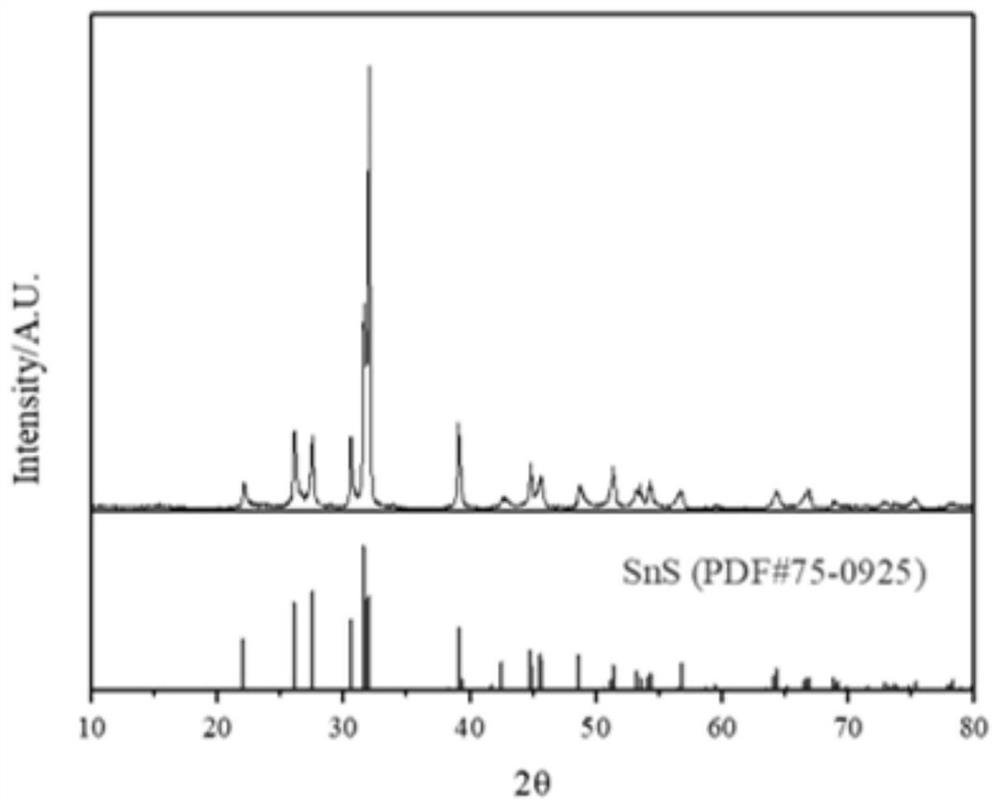One-step method for preparing nano-tin sulfide from tin-containing electronic waste
An electronic waste, stannous sulfide technology, applied in chemical instruments and methods, tin compounds, nanotechnology, etc., can solve the problems of harsh preparation conditions, coarse particle size, low yield, etc., and achieve the effect of efficient and selective separation
- Summary
- Abstract
- Description
- Claims
- Application Information
AI Technical Summary
Problems solved by technology
Method used
Image
Examples
Embodiment 1
[0025] Using tin-containing electronic waste pyrolysis slag as raw material (tin content 9.2%, organic content 0.5%), add composite additives according to the amount of Sn / S=2.0 (composite additives are a mixture of calcium sulfide and silicon dioxide, the proportion (Ca / Si=2.2), mix it thoroughly and make agglomerates, then place the dried agglomerates in a two-stage controlled atmosphere roaster for controlled atmosphere roasting; the material is placed in the first stage of roasting area, and the first stage of roasting is strongly reduced The atmosphere is CO and CO 2 Mixed atmosphere, the concentration is CO / (CO+CO 2 )=10vol.%, the roasting temperature is 900°C, and the gas flow rate is 0.3m / s; the volatile products enter the second-stage roasting area with the airflow, and the weakly reducing atmosphere of the second-stage roasting is CO and CO 2 Mixed atmosphere, the concentration is CO / (CO+CO 2 )=5vol.%, the roasting temperature is 700°C, and the gas flow rate is 0.5...
Embodiment 2
[0027]Using tin-containing electronic waste pyrolysis slag as raw material (tin content 9.2%, organic content 0.5%), add composite additives according to the amount of Sn / S=1.5 (composite additives are a mixture of calcium sulfide and silicon dioxide, the proportion (Ca / Si=2.0), mix it well and make agglomerates, then place the dried agglomerates in a two-stage controlled atmosphere roaster for controlled atmosphere roasting; the material is placed in the first stage of roasting area, and the first stage of roasting is strongly reduced The atmosphere is CO and CO 2 Mixed atmosphere, the concentration is CO / (CO+CO 2 )=10vol.%, the roasting temperature is 850°C, and the gas flow rate is 0.3m / s; the volatile products enter the second-stage roasting area with the airflow, and the weakly reducing atmosphere of the second-stage roasting is CO and CO 2 Mixed atmosphere, the concentration is CO / (CO+CO 2 )=3vol.%, the roasting temperature is 650°C, and the gas flow rate is 0.4m / s; th...
Embodiment 3
[0029] With tin-containing electronic waste pyrolysis slag as raw material (tin content 9.2%, organic matter content 0.5%), add composite additive for Sn / S=1.8 according to dosage (composite additive is the mixture of calcium sulfide, silicon dioxide, its proportioning (Ca / Si=2.1), mix well and make agglomerates, then place the dried agglomerates in a two-stage controllable atmosphere roaster for controlled atmosphere roasting; the material is placed in the first-stage roasting area, and the first-stage roasting has strong reducibility The atmosphere is CO and CO 2 Mixed atmosphere, the concentration is CO / (CO+CO 2 )=8vol.%, the roasting temperature is 800°C, and the gas flow rate is 0.2m / s; the volatile products enter the second-stage roasting area with the airflow, and the weakly reducing atmosphere of the second-stage roasting is CO and CO 2 Mixed atmosphere, the concentration is CO / (CO+CO 2 )=2vol.%, the roasting temperature is 550°C, and the gas flow rate is 0.2m / s; the...
PUM
| Property | Measurement | Unit |
|---|---|---|
| specific surface area | aaaaa | aaaaa |
Abstract
Description
Claims
Application Information
 Login to View More
Login to View More - R&D
- Intellectual Property
- Life Sciences
- Materials
- Tech Scout
- Unparalleled Data Quality
- Higher Quality Content
- 60% Fewer Hallucinations
Browse by: Latest US Patents, China's latest patents, Technical Efficacy Thesaurus, Application Domain, Technology Topic, Popular Technical Reports.
© 2025 PatSnap. All rights reserved.Legal|Privacy policy|Modern Slavery Act Transparency Statement|Sitemap|About US| Contact US: help@patsnap.com

